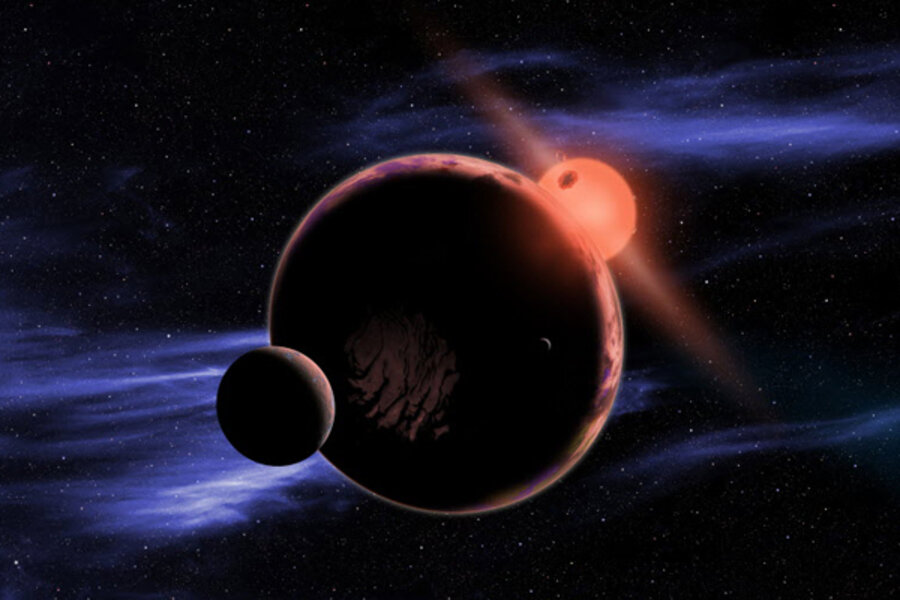Earth-like planets next door? Prospect could point to 9.6 billion more
Loading...
| Boston
The nearest potentially habitable, Earth-like planet may be a scant 13 light-years away – close enough that any hypothetical, tech-savvy inhabitants there could start enjoying the second season of "The Sopranos" right about now.
Indeed, there should be at least three Earth-size planets orbiting in the habitable zones of stars within 33 light-years of Earth, according to a new analysis of data from NASA's Kepler mission.
That would put detailed studies of such planets – and the hunt for signatures of life on them – well within the reach of a new generation of space telescopes, including the James Webb Space Telescope, currently slated for launch in October 2018.
Launched in March 2009, Kepler is monitoring some 158,000 stars across the constellations Cygnus and Lyra for signs of planets. The ultimate goal is to detect Earth-like planets orbiting sun-like stars.
Along the way, however, the mission has also been gathering statistics on the size and type of planets orbiting different stars. Based on those data, the team conducting the new study concludes that some 6 percent of the smallest, coolest types of stars in the galaxy – red dwarfs – host planets with a mass similar to Earth's that are also in habitable zones.
Up to 80 percent of the stars in the galaxy are thought to be red dwarfs. If 6 percent have an Earth-like planet, that means the galaxy could host between 9.6 billion and 19.2 billion potentially-habitable Earths around these stars alone.
The results reinforce a growing recognition that our solar system, with its larger, hotter star, "is quite rare," says John Johnson, an astronomer at the California Institute of Technology in Pasadena who studies extrasolar planets. "It's quite remarkable that the vast majority of habitable planets throughout the galaxy are likely around these red dwarfs."
The results also "highlight just how quickly the field of extrasolar planets is blooming," he adds.
In 2000, astronomers had only detected 33 planets, all gas giants the size of Saturn or larger. They have now found 3,300, when Kepler's planet candidates are included.
The new study, conducted by Harvard University graduate student Courtney Dressing and astronomer David Charbonneau at the Harvard-Smithsonian Center for Astrophysics in Cambridge, Mass., casts a new eye on the red dwarfs previously cataloged by the Kepler team.
To begin with, the duo had to estimate the stars' masses, temperatures, and other factors that bear on where a habitable zone would fall and where planets would orbit. Using the Kepler observations and star traits based on a recent model well suited to characterizing low-mass stars, Ms. Dressing and Dr. Charbonneau found evidence for 95 planets orbiting 64 stars. Of those, 60 percent were smaller than Neptune, the smallest gas giant.
"That's a remarkably large number," Dressing said during a press briefing on Wednesday announcing the results.
Among the planets, three appear to be Earth-mass planets orbiting within their star's habitable zones. The team then estimated the number of such planets that Kepler can't find. That yielded the estimate that 6 percent of red dwarfs host Earth-mass planets in their habitable zones.
These stars, however, are between 300 to 600 light-years away. Applying the estimate to the sun's neighborhood, which hosts some 284 red dwarfs within about 33 light-years, the team estimated that the nearest habitable planet is likely to appear about 13 light-years from Earth.
Some scientists have long seen red dwarfs as potentially important hosts for habitable planets – in no small part because of their longevity. They are small, typically only 25 percent the mass of the sun. They burn low and slow. Theoretical calculations suggest that their life spans could reach or even exceed 60 billion years – longer than the universe is expected to last – compared with the approximately 5 billion years our sun has left before it expands into a red giant, only to collapse into a white dwarf.
Thus, life would have plenty of time to evolve on a red dwarf, if it gained a toehold.
Initially many researchers assumed that a planet in a habitable zone would be gravitationally bound to the star in such a way that it presents the same hemisphere to the star throughout its orbit. This would toast the sunward hemisphere and send the other hemisphere into a deep freeze.
But as more planets of all types have been discovered, it seems that may not always be the case. A planet could mimic Mercury's slow, rotisserie-like rotation. Or its orbit could be highly elliptical, ensuring that it would rotate and move far enough away from the star not to over-bake.
What's more, a thick atmosphere and deep oceans could allow the transfer of heat between the two hemispheres, moderating the otherwise extreme conditions. And the permanent "twilight zone" between day and night hemispheres could itself host potential habitats.
There, much depends on what happens during the first 10 to 20 million years of the system's history, when the young star is far more active. During that time, large flares and more-intense stellar winds could strip a habitable-planet wannabe of any atmosphere. And the star's intense ultraviolet radiation could sterilize the surface.
Still, red dwarfs' stock as a potential host to a habitable solar system has risen, Charbonneau suggests.
In the past, some researchers developed carefully "carefully constructed arguments as to why life couldn't exist on a planet orbiting a red dwarf," he says. "I think that with hindsight, we see that as a myopia for having grown up around a sun-like star."







